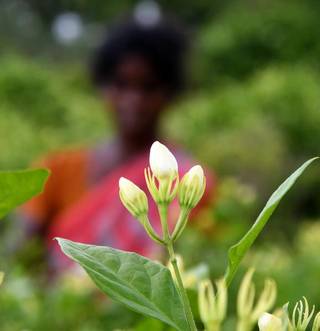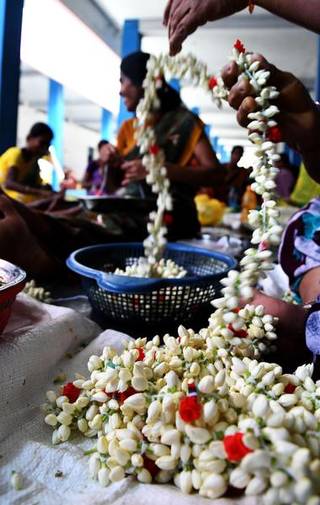
It’s a hot, uninviting terrain but it is here that the Madurai malli thrives and grows
Off the Madurai-Aruppukottai highway, a little away from the airport, a road winds through solitary palm trees. On either side is burnished landscape in various shades of brown glistening in the summer sun. Shielded within this terrain are acres and acres of fields dotted with dark green plants — the Madurai malli. Groups of women are at work, plucking flowers and weeding, and by 10 a.m., they are done for the day.
“A good worker can make about ₹7,000 a month,” says M. Ramar, 42, who owns about 12 acres of land in the tiny village of Melaupplikundu. His wife, Lakshmi, also works with the women in the fields, and their day begins as early as 3 a.m. Armed with headlamps, they make their way to the farm to pick the plump white buds and don’t stop until it’s time for the morning rice gruel.
By 10 a.m., Ramar completes five trips to the flower market in Villapuram, carrying 20 kilos of flowers on his motorcycle. It’s about 20 km from his village to the market, and Ramar zips on the highway. Even the smallest delay can cause the buds to unfurl in the heat.
Ramar is one of the hundreds of farmers in the district that’s famous for the Madurai malli, the jasmine with a GI tag. Madurai and Dindigul together have some 2,000 hectares under cultivation.
But Madurai is only the second home of the eponymous flower. Its birthplace is actually a tiny village called Thangachimadam on Rameswaram island, some 160 km or four hours away.
****
It all began in the summer of ’50. Betel leaf armer T. Subbiah Kumar stepped out of his home in the blinding light. The cool sea breeze had long dissipated and Thangachimadam, just 3 km inland, was simmering. Farmers in this little speck of a village lived off the cultivation of betel leaves. Lost in thought, Kumar made his way to the farm. Of late, men from the island had been steadily leaving for the mainland in search of work. Betel leaf cultivation being labour intensive, Kumar was finding the going hard. He planned to visit Coimbatore Agricultural College soon, hoping to get a new high-yielding variety.
___________________________
- In 1962, The Hindu started using an Indian Airlines special flight to transport bundles of the newspaper to the temple town of Madurai. By September the next year it had bought its own aircraft, a Heron. The then small military airport in Madurai was used to land the plane and offload the bundles. As the aircraft had to return empty, it struck someone that jasmine flowers could be loaded in it for the export market. Nagarathnam of S.N. Exports chuckles. “It was The Hindu that opened up the world market for Madurai malli.”
_____________________________
The visit did take place and it changed not just Kumar’s life but also the landscape of Thangachimadam. In the agricultural college, he saw a jasmine plant being layered and, on a whim, brought back one sapling for the women at home. Once the plant grew, instead of propagating it using the layering method, he just cut a stem and plonked it a little distance away.
In a few weeks he was stunned to see the stem sprout a lush growth of tiny new limbs. In no time, his farm was teeming with rows and rows of jasmine saplings. At this time, jasmine farmers in Madurai and its peripheries were using only the layering method to propagate the flower. It took a long time for the plant to take root in the gravelly earth with its thick under-layer of clayey soil. Though the perfume was heady, the flowers were few and enough only to supply the local market.
One day, S. Nagarathnam, a flower-seller’s son who owned a few acres of farmland in Madurai, stumbled upon the Thangachimadam saplings. He planted a few on his plot and found that not only did they take root immediately, they also flowered profusely.
According to Kumar’s son Thavasi, who now runs a nursery in Thangachimadam, this realisation was the eureka moment for the Madurai malli. As we talk, he bends down to tug at a little sapling and uproots it for me to see. There is one primary root hidden in a maze of secondary roots. The sandy terrain and loose soil help the roots penetrate deep and proliferate. Till the saplings take root, coconut fronds are woven and layered like a shamiana to protect them from the harsh sun.
Once fresh leaves spring forth, the fronds are removed and the plants bask in the heat. In three months, the saplings are uprooted, tied in bundles, and sent for replanting, some as far away as Mumbai.
But without a doubt, the jasmine is at its seductive best only in the hinterlands of Madurai. Replanted here, the hundreds of secondary roots cling to the gravelly soil while the primary root goes deep into the clayey soil. In this uninviting terrain, the Madurai malli is reborn, hiding a heady perfume within its thick petals.
****
It is in summer that jasmine thrives. Of course, the plants need plenty of water. Like other farmers, Ramar too has deepened his borewell and invested in drip irrigation. The regulated supply helps the plants, he says.
A three-acre plot is divided into three sections, with plants in one acre watered for 10 days continuously. On Day 11, the buds are ready for harvest. The plants flower continuously for the next 20 days. On Day 20, the second acre is watered and by the time the first acre stops flowering, the second begins to bloom. As Ramar says, flowering is continuous in summer; daily average yields can be 9 kg per acre. The regimentation maintains a steady supply to the market.
Summer showers can be scary though, says Ramar. If it rains two days at a stretch, the flowering is prodigious, leading to a glut in the market. From mid-December to mid-February, when mist covers the region, the plants lie dormant. An occasional bud or two may be healthy enough to fetch the farmers a good price.
****

Madurai malli is a capricious child, says Nagarathnam, 70, proprietor of S.N. Exports, as he lovingly scoops out a handful of blooms from a sack. It is 6.30 a.m. and the flower market at Villapuram is bustling. Farmers carrying sacks of flowers enter the market, which is located in the middle of a housing board colony and roofed with corrugated sheets.
Nagarathnam’s grandson Mahesh, an engineer who left his job in Saudi Arabia to look after the family business, sits at a table on a raised platform. Weighing the flowers brought in from various parts of Madurai, he and a few others place half a kilo each of the tight buds into plastic baskets.
In an hour, P. Mukamma, 65, arrives, carrying a little tiffin-carrier, picks up a basket, and settles down against a pillar to start stringing the buds together. She is soon joined by about 50 other women, all stringing jasmine.
In another corner, some men are busy soaking gel sheets in water. Once the little chambers in the sheets puff up, they are placed in a refrigerator. By 11.30 a.m, P. Pothiraja, 28, is at his desk, readying thermocol cartons. Some men wrap the buds, now all in strands, in thick paper sheets, while others pack them in plastic bags.
These are all brought to Pothiraja who lines the thermocol cartons with butter paper and frozen gel sheets before putting in the precious cargo. Within the next hour, the cartons are on their way to Madurai airport from where the flowers will fly to Singapore, Malaysia, Dubai, Canada and the U.S. Two tonnes of jasmine are exported every day.
N. Karthikeyan, Nagarathnam’s son, says the packaging is good enough to survive the long journey, and the buds do not bloom until the carton is opened, and sometimes not till two whole days later. But exporting is risky business, and Karthikeyan recalls the time an entire consignment to Dubai went to waste after a worm was discovered nestling in the flowers. But business is otherwise good, he says, and as long as women love flowers and people need them for pujas and weddings and parties, there will always be a market for the Madurai malli.
beulah.r@thehindu.co.in
source:http://www.thehindu.com / The Hindu / Home> Field Notes> Society / by Beulah Rose / May 26th, 2018
